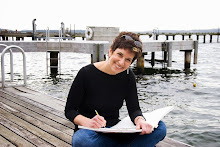"One Foot on the Path", oil on 32x48" panel, hanging at the Governor's Mansion in Olympia for one year along with eleven more of my paintings
Writing a good speech is second to none on the pain scale
except the actual giving of the speech. You want it to be no less than great so
right there you’re already in trouble. After seeing numerous Ted Talks, we all know
what 22 minutes looks like and how good it looks when the giver isn’t reading
from notes, uses inflections in their voice, poses with appropriate physical motions
with and amazes us with a fabulously interesting topic.
So I did what everyone does. Well, after I panicked anyway, I
looked it up on-line. I looked up how to write a speech, I poured over a scientific
analysis on what makes up a great speech, I read about how to practice a
speech, and I read and watched some really great speeches. Then I was truly
stumped. I don’t have a PhD on studying the brain and then had a stroke so got
to give a speech about what that felt like (which is one of the best Ted Talks).
I’m not Abraham Lincoln or Martin Luther King, both incredibly fantastic speech
writers and great thinkers. I’m not the best artist I know nor have I won
incredible prizes for my painting or had to paint holding the brush in my teeth
because I don’t have any arms. It’s just me, folks, and I had to write a speech
and give in at the Governor’s Mansion in Olympia. The invitations said the
artist was “giving a lecture”. That threw me even more. A lecture sounds much
more important than just a speech.
So I turned to my friends and relations to discuss what
subject would be good for this speech. I knew it had to be on a subject I cared
about and knew a lot about. My uncle, who was a judge and has given many
speeches told me that what people really want to hear, was simply about my “journey
to becoming an artist and leave out politics and religion, kid.” He always
calls me kid. I could do that. I certainly knew the subject.
So I wrote and wrote and wrote. I looked up quotes (boy
there are a lot of great quotes out there) and filled my speech with everything
I could think of that related to art from the beginning of my life to the present
day. And after a while, though it was much too long and didn’t exactly flow, I
began to see this might work after all. Especially if I tossed out aiming for great.
After much editing and working on flow, I needed to read it out loud to someone
who would tell me truthfully if it was working at all, where the weaknesses
were and if it would offend anybody. I was two days away from giving the speech
when I realized that I’d better leave out the name of my university since it’s
art department wasn’t portrayed in a very flattering manner! Imagine all those
alumni in the audience tittering afterwards had I not just called it “my
college”. A dear friend, who had been my
teacher when I was at the Gemological Institute of America, and gives talks all
the time to large and small groups kindly offered to be my first listener. I am
a firm believer in never anything I work on leave the house without another set
of eyes on it. Debbie offered great hints and kind words which left me feeling
surprisingly confident.
And then you have to practice. Routines work for me so every
morning, after my shower, I placed my
speech on top of a tippy small table placed on a chair to imitate a podium and read
my speech out to the world through the open sliding doors of the master
bedroom. I told the sky how I grew up in a lovely, loving family. The birds
squawked when they heard me tell that I created some weird art in college. Over
and over and over I said it because I couldn’t imagine that I would ever get
this thing memorized. My brain seemed too porous to hold it. Paragraphs ended
and I was left wondering what came next. But the amazing thing was that after I said it
a jillion times, it eventually did start to tumble off out of my mouth
unbidden. The transitions began to come more naturally and I found I could even
adlib a little to help the speech along.
The day to give the speech finally came and though my heart
really did hammer like a madman for the first five minutes, I remembered to
breath and eventually I actually got the point where I slowed down the pace,
relaxed and actually enjoyed the rest of the speech. Who’d have thought? I
think the take away for me on this whole speech thing was something I learned
from another friend of mine who encourages taking a big project and breaking it
into smaller pieces in order to make it seem less overwhelming. At some point,
I just told myself to quit complaining and worrying about it and just get on
with working on it. Just do it—thank you Nike. I’m not sure I’ll ever willingly
take up speech giving as part of my career but if it comes up again, I’ll know more or less what to do. There’s
something quite positive to be said for getting through the terribly, awful and
wonderful process of writing and giving a speech.







